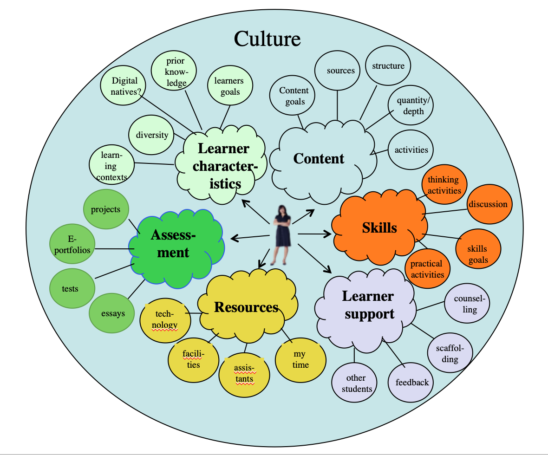
This is the fifth in a series of posts on online learning in the (k-12) school sector.
The first is: What needs to be done about online learning in the school sector? 1. An introduction.
The second is: Online learning and (k-12) schools: 2. Technology and cost issues
The third is: Online learning and (k-12) schools: 3. Do we need a different curriculum for online learning?
The fourth is: Online learning and (k-12) schools: 4. The role of parents
Learning environments
In my book, Teaching in a Digital Age, I point out that there are many different learning environments. School is one very important learning environment, but there are others, such as nature or camps, the home, or even work. Online learning is just another learning environment.

For a learning environment to be effective though it must have certain elements that support learning. I set out one example in Figure 1 above. Many of these elements are similar whether the environment is a school classroom or an online course or program. If any of these elements is missing or of poor quality, learning is likely to be more difficult if not impossible.
Most of these elements need little discussion, but in my book I state that ‘within every learning environment there is a prevailing culture that influences all the other components.’
What do I mean by culture?
I define culture as the dominant values and beliefs that influence decision-making.
The choice of content, the skills and attitudes that are promoted, the relationship between instructors and students, and many other aspects of a learning environment, will all be deeply influenced by the prevailing culture of an institution. Thus in a learning environment, every one of the components I described will be influenced by the dominant culture.
One important point for teachers to remember is that online learning is a different environment from a school, which tends to have a certain ‘historical’ culture that prevails across the school. When a course is moved online, teachers especially should reflect on the culture they would like to see within their online class. It does not need to be the same as the overall culture in the school; it could be completely different.
Parents too will have views on what is an appropriate culture, but the teacher is in a particularly influential position in an online course in setting the overall tone and influencing the values and beliefs within that online class. If the teacher is happy with the culture of their in-person classes, then they will need to work to ensure those values and beliefs are represented within the online learning environment. However, moving online into a different learning environment also offers the opportunity to set a different tone or culture of learning, either by default or by intent.
Creating a culture that supports learning online
Because the learning environment online is different from in-class, teachers need to think carefully on what values and beliefs they want to prevail within an online learning environment, and how these can be fostered online. I give an example below:
- mutual respect (between instructor and students, and especially between students)
- open-ness to differing views and opinions; respect for diversity
- evidence-based argument and reasoning
- making learning engaging and fun
- making explicit the underlying values and epistemology of a subject discipline
- transparency in assessment (e.g. rubrics and criteria)
- recognition of and respect for the uniqueness of each student in the class
- collaboration and mutual support.
The above cultural elements of course reflect my beliefs and values in higher education; in a school environment, each teacher may want something quite different. However, teachers should be conscious of their beliefs and values, so that they can design the learning environment in a way that best reflects such values. Each of the values listed above requires a specific effort on the part of the teacher and will affect especially areas such as online discussion forums, choice of topics, learning activities and type of assessment, and the organisation of the teaching. In an in-person classroom, many teachers will do this unconsciously; in a different environment such as online learning, this may need more explicit and focused actions by the teacher.
Lastly you may question the right of a teacher to impose their personal cultural values and beliefs on a learning environment. For myself, I have no problems with this. As subject experts or professionals in teaching, they are usually in a better position than learners (or, more arguably, parents) to know the learning requirements and the cultural elements that will best achieve success for their students. In any case, if you believe that learners or parents should have more say in determining the culture in which students will be learning, that too is a choice and could be accommodated within the culture. The main difference between in-person and online teaching is that the embedded cultural values become more explicit or evident online, because they leave a digital trace.
Conclusion
Culture is a critical component of any learning environment. It is important for teachers and parents to be aware of the influence of culture within any particular learning context, and to try and shape that culture as much as possible towards supporting the kind of learning environment that they believe will be most effective.
Changing a pre-existing, dominant culture is very difficult. Nevertheless, online learning enables new learning environments to be developed, and thus provides an opportunity to develop the kind of culture within that learning environment that will best serve the students. But it won’t happen by accident; it needs specific actions on the part of the teacher. Without that, online learning runs the serious risk of being sterile.
Up next
The strengths and weaknesses of online learning.
This will be followed by the final post, which will be the fun part of the series: Ministry policies for online learning – it’s all been leading to this.









 Dr. Tony Bates is the author of eleven books in the field of online learning and distance education. He has provided consulting services specializing in training in the planning and management of online learning and distance education, working with over 40 organizations in 25 countries. Tony is a Research Associate with Contact North | Contact Nord, Ontario’s Distance Education & Training Network.
Dr. Tony Bates is the author of eleven books in the field of online learning and distance education. He has provided consulting services specializing in training in the planning and management of online learning and distance education, working with over 40 organizations in 25 countries. Tony is a Research Associate with Contact North | Contact Nord, Ontario’s Distance Education & Training Network.

